千葉市立加曽利貝塚博物館 > 総合案内 > 「加曽利のヒト O's Room」更新
ここから本文です。
更新日:2025年3月27日
加曽利のヒト O's Room
この『加曽利のヒト』では、加曽利貝塚博物館に勤務する事務員が、縄文時代や史跡に触れて感じたことや、博物館、縄文時代の魅力をご紹介します。
March26,2025
We can speculate about the unknown using artefacts and objects discovered from the past.
残されていない物を残されているものから推測する。
Fishing hooks were found. Then how about the fishing line? It was never found. It is considered that it was made of plant fibers. So, plant fibers usually decompose and don’t exist forever.
釣り針は見つかっている。では、釣り糸はどうだろう?残っていない。草木の繊維から作られていたと推測されており、従って通常溶けて残らない。
Although this is just speculation, it can be made using the following process:
想像ではあるが、次の様に作ることが出来る。

This is a plant called Ramie, which is widely spread throughout Japan.
からむしという全国に広く分布している植物がある。


Take off the leaves.
葉を取り除く。

Fold the stalk and rub well.
折って良く揉む。

Peel off the skin.
表皮をはぎ取る。


Soak in water to soften the skin.
水に浸し、皮を柔らかくする。

Put the ramie stalk onto a board and prepare a shell.
板の上に取り出し、貝を用意する。

Rub the shell against the stalk.
貝を押し付け…

Move it by pressing hard and peel off the skin.
強く押しながら動かし、表皮(外皮)を剥ぎ取る。

Only the plant fibers are left. So many thin fibers appear. It looks like the plant fibers are becoming more transparent in the water, so it can be assumed that it is difficult for fish to see the fibers.
繊維のみとなる。たくさんの細い繊維が現れる。水につけると更に透明になるように見え、魚の目は欺けそう。

Divide these into smaller pieces and separate them until they become so thin that the fish can’t see them. Although they are quite thin, they are extremely strong. After attaching the hook to the fibers, they can’t be cut easily, even if a fish pulls hard. I tried pulling hard because I wanted to know how much strength the fibers could tolerate, but my finger was almost cut, so I gave up checking the strength with my finger. Maybe, I can catch a fish that weighs a few kilograms without cutting the line made from plant fibers. Make a line several tens of meters long so that it can reach the fish which live far and deep in the sea.
これを小分けにして、魚が見えない細さになるまで取り分ける。非常に細いが、強度はかなりある。これに針を付けて魚が強く引っ張っても、簡単には切れないだろう。どのくらいの強さまで耐えられるか知りたくて強く引いてみたが、自分の指が切れそうになったので、指で強度を確認することはやめた。多分、数㎏の魚なら切れず、釣れるはず。これを遠く深い海中に住んでいる魚に届くまで、数十メートルの長さの糸を作る。
Next, I’ll try making a hook for fishing.
I must work hard in order to make a living.
次は釣り針を作ってみよう。
生きるためには頑張らないと。
October 20,2024
縄文土器の縄の文様を作ろう!
Let's make the net pattern of Jomon pottery!
簡単に縄文土器の縄の文様を作れます!
Jomon rope cord pottery patterns can be easily made!

これは本物の土器の欠片です。
These are pieces of real pottery.

始めに粘土を用意します。
(実際は土です。)
First, prepare the clay.
(Actually, it’s soil.)

次に繊維をより合わせた糸から作られた糸を木の枝に巻き付けます。
Next, wrap the rope made from the twisted fibers around the thin branch.

それを押し付けて…
Push the rope onto the clay…

転がして…
Roll it…

終わりです。
簡単!
and finished!
So easy!

これは家に持ち帰ることが出来ます。
It can be taken home.

家に着く頃には乾いて硬くなります。
(実際は火で焼いて固めます。)
It will have become hard by arrival.
(Actually, these are hardened by being fired.)


他にも様々な文様があります。
There are various patterns as well.

毎月最終週の土曜日(12月除く)に体験プログラムを実施しています。
We hold experiential programs on the last Saturday of each month, except in December.
https://kasorijomon.com/?page_id=296(外部サイトへリンク)(別ウインドウで開く)
https://www.city.chiba.jp/kasori/news/2022_hakutu-kousaku.html(別ウインドウで開く)
https://www.city.chiba.jp/kasori/infomation/hands-on/index.html(別ウインドウで開く)
加曽利貝塚博物館にはたくさん土器があり、それぞれに様々な文様があります。
自分で作った後にこれらを見てみてください。
There is so much pottery in the Kasori Museum and the pottery pieces have various patterns on them.
It is good to look at these pottery pieces after creating a pottery piece.


https://www.city.chiba.jp/kasori/news/2024_eshiki.html(別ウインドウで開く)
September20,2024
Climate Change Makes Periods
気候変動が時代を作る
I will focus on the temperature and population changes all over Japan.
気温の変化と日本全体の人口の増減に着目する。
About 80,000 years ago
The beginning of Ice Age
約8万年前
氷河期の始まり
About 40,000 years ago
People started to live in the Japanese Archipelago.
約4万年前
日本列島に人が住み始める。
About 23,000 years ago
The oldest fishing hook in the world (Sakitari-do cave site, Nanjo City, Okinawa Prefecture)
約2万3,000年前
世界最古の釣り針(沖縄県南城市サキタリ洞遺跡)
About 20,000 years ago
The peak of the glacial period
The temperature was 6 to 9 degrees lower than now, and the sea level was also 100 meters lower.
約2万年前
寒冷期のピーク
今より6-9度低い、海面も100m低い。
About 16,500 years ago
The oldest piece of pottery in the world (Odai-Yamamoto Site, Aomori Prefecture)
約16,500年前
世界最古の土器(青森県大平山元遺跡)
About 11,000 years ago
The oldest piece of pottery from Chiba City (Sakanokoshi Site, Asumigaoka, Midori Ward, Chiba City, Chiba Prefecture)
The world began warming.
約11,000年前
千葉市内最古の土器(千葉市緑区あすみが丘の坂ノ越(さかのこし)遺跡)
温暖化に転じる。
About 8,000 years ago
The oldest piece of pottery from the Kasori Shell Mounds
約8,000年前
加曽利貝塚最古の土器
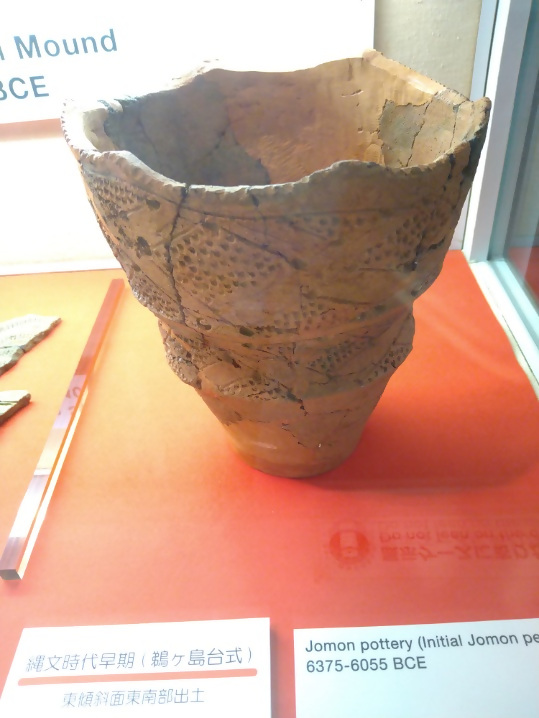
About 7,000 years ago
This was during a period of global warming. However, there was a brief time when it became colder.
約7,000年前
温暖化傾向であったが、この頃いったん、寒冷になった時期あり。
About 6,000 years ago
The world was warming.
The temperature was about 2 degrees higher than now, and the sea level was also 3 to 4 meters higher.
(There was a day in August 2024 when it was over 35 degrees in Chiba City. Could there have been hotter days than this in the past? Recently, winters have been around 6 degrees in January.)
約6,000年前
温暖化。
今より2度ほど高い。海水面も今より3,4m高い。
(千葉市では2024年8月に、35度を超える日もあった。これより暑い日もあっただろうか?冬は近年の1月で6度前後。)
About 5,000 years ago
There was a time when it became colder.
約5,000年前
この頃、寒冷になった時期あり。
From about 5,000 to 3,000 years ago
The world began warming.
Large shell mounds were formed in Kasori.
約5,000年前から3,000年ほど前
温暖化に転じる。
加曽利貝塚に巨大な貝塚が形成される。
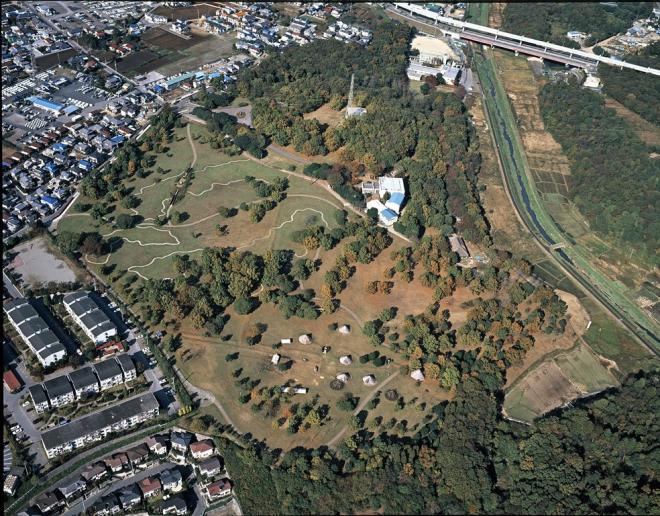
From about 3,000 to 2,000 years ago
Food shortages caused by cooling led to a decrease in population.
(Although the number of ruins decreased and their size became smaller, larger ruins have also been discovered. It is unclear whether or not the population decreased. In this blog, I am of the opinion that the population decreased and will continue with this theory for my blog.)
The temperature was about 2 degrees lower than now, and the sea level was also 3 to 4 meters lower.
The remains excavated from the Kasori site also decreased after this period. It is thought that the people from this area migrated to find food.
約3,000年前から約2,000年前
寒冷化による食料不足で人口減少。
(但し、遺跡数が減り、遺跡規模が小さくなっているが、大きな遺跡も発見されており、人口減少したかは定かではない。このブログでは減少したとする説をとり、話を進める。)
今より2度ほど低い。海水面も今より3,4m低い。
加曽利貝塚からも出土する遺物もこの頃以降減少し、食料を求めて移住したと推測されている。
After that
With the warming climate, agriculture(rice cultivation)gradually spread around Japan and the population increased again.
Adding bronze and iron artefacts marked the beginning of a new era.
(There is an opinion that, due to food shortages caused by climate cooling, they adopted agriculture as new way to make up for it.)
その後
温暖化により農耕(稲作)が徐々に広く行われるようになり、再び人口が増加し、青銅器、鉄器も加わり、新しい時代が始まる。
(寒冷化して食料不足となったため、その穴を埋めるために新たな農耕文化を受け入れたとする見方もある。)
To put it in broad terms…
With rising temperatures, food became more abundant, the population increased(※), various lifestyles emerged. With cooler temperatures, this led to a shortage of food, which resulted in the population decreasing. (This is strictly my personal feeling.)
(※)The population is considered to have been approximately a few hundred thousand at its peak. (There are various opinions.)(By the way, the population was 124million in March 2024.)
大きな流れで言うと…
温暖化により食料が豊かになり人口が増え(※)様々な生活態様が生まれ、寒冷化により食料が減り人口が減った。(あくまでもこれは個人的な感じ方です。)
(※)人口は多いときで数十万人ほどだったとされています。(色々な意見があります。)(ちなみに2024年3月は1億2,400万人。)
For one moment in a long history, the Jomon Period flared up briefly like fire and then disappeared. The setting of the Jomon period was quite different when compared to the previous and future scenes of the Jomon period. The previous scenes was the Paleolithic Period of the Ice Age, which was characterized by a migratory lifestyle, and the future scenes was the Yayoi Period, which was a completely different setting enriched by foreign cultures, due to the world warming again. Just like the rising of a curtain marking the beginning of a performance, the people of this period flourished for only about 14,000 years until the curtain fell, marking the end of the Jomon Period. I had the impression that this period seemed a somewhat dull period that has an earthy plain smell due to the image I had of pottery. However, looking at the flow before and after this period and comparing its trends with the surrounding periods, I think it was a uniquely dynamic and distinctive period. Of course, climate is not the only reason, but I'm sure it was one of the main factors.
長い歴史の中で一瞬、炎のように燃え上がり、消えた。その前後、氷河期の旧石器時代の移住生活と、再び温暖化し外来文化で彩られ変化していく弥生時代の生活の間にあって、まるきり違う一幕。幕が上がり、ほんの1万4,000年ほど栄え、幕が下りるように終焉していく。なんとなく、土器のイメージから土の地味なにおいのするつまらない時代の様に思えたが、こう時代の前後の流れを見て、その実態を前後と比較して見ると、変化に富んだ特異な一時代であったと思う。もちろん気候だけが理由ではないが、それが大きな理由の一つであったことは間違いないと思う。
Things that I personally think blossomed particularly during the Jomon period.
縄文時代で特に華開いたと個人的に強く感じたもの…
1Pottery as an invention
土器という発明品
2Fashion and Style
服飾・おしゃれ
3Fishing nets
漁労の網
4Prayer
祈り
5The range of interaction through the movement of goods
物の移動からみる交流範囲
6What is a Dogu?
土偶とは何か
7Knitting and Sewing Techniques
編む、縫うという技術
8Dwellings
住居
1Pottery as an invention
土器という発明品
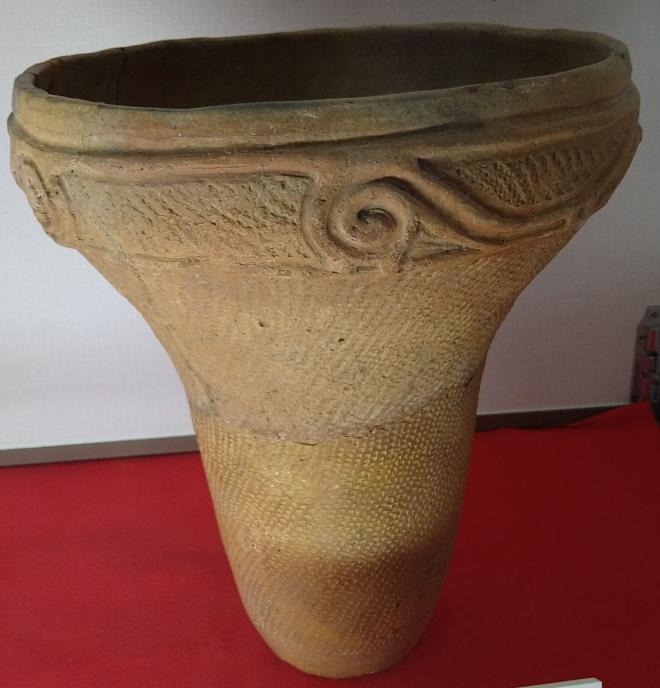
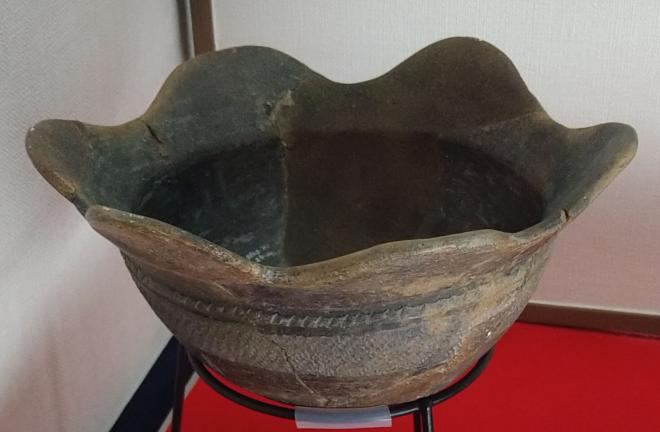
Pottery was invented and developed as a tool for boiling in this period. It's easy to imagine how it significantly changed people's eating habits. I think it was a breakthrough invention. The period when pottery with net patterns was dominant is known as the Jomon period(Jomon period縄文時代、Jou縄=rope, mon文=cord), but it's surprising that this preference remained unchanged for even about 14,000 years. Ukiyo-e or Manga had not appeared yet.
土器は煮炊きする道具としてこの時代に生まれ発展したもの。これでかなり食生活が変わったであろうことは容易に想像できる。画期的な発明品だったと思う。縄の文様のある土器の時代なので、縄文時代というが、1万4,000千年間ほどもこの好みが変わらなかったことは驚き。浮世絵や漫画はまだ登場しない。
There must have been many different types of dishes. We can tell what they ate from the artefacts and the composition of human bones, but unfortunately, we can't know what kinds of dishes they made or how many different cooking types they had, because no recipes have remained. I wish there had been a recipe that was recorded in writing on a clay tablet.
料理の種類もたくさんあったはず。人骨の成分や遺物から何を食べていたか分かるが、レシピが残っていないのでどんな料理だったか、どれだけ多くの料理の種類を持っていたかまでは残念ながら分からない。土版に文字で記録されたレシピがあったら良かったのに!
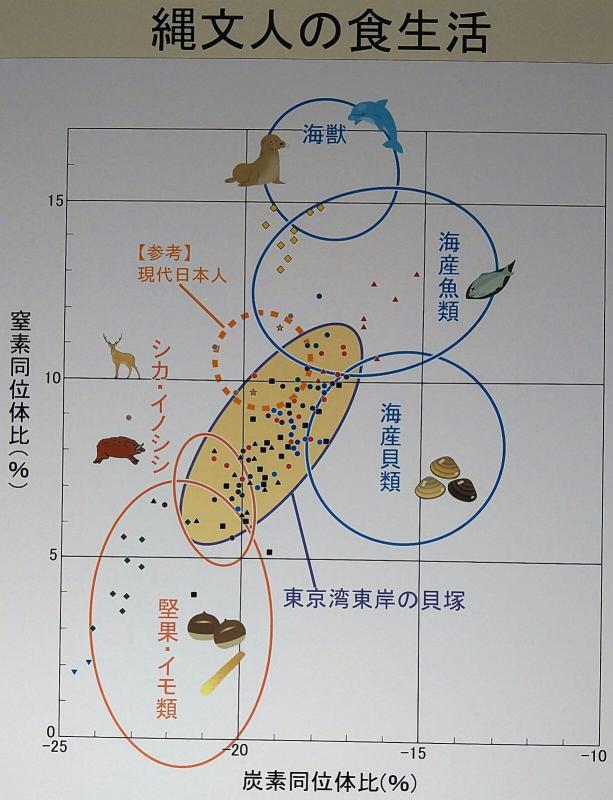
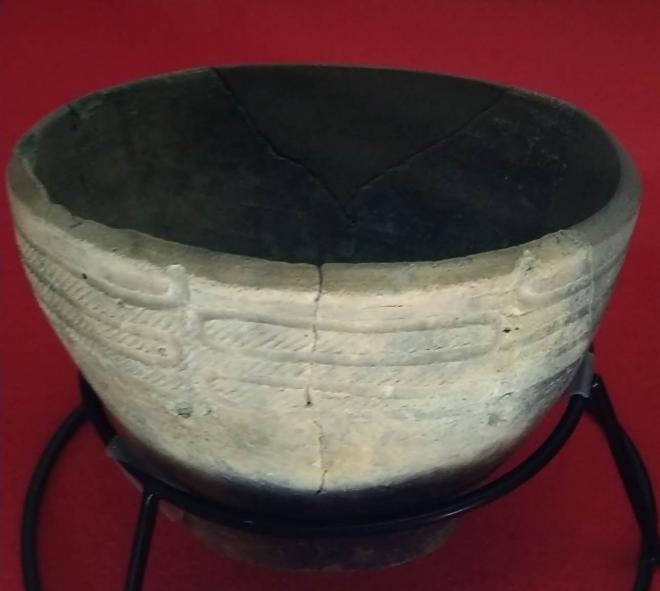
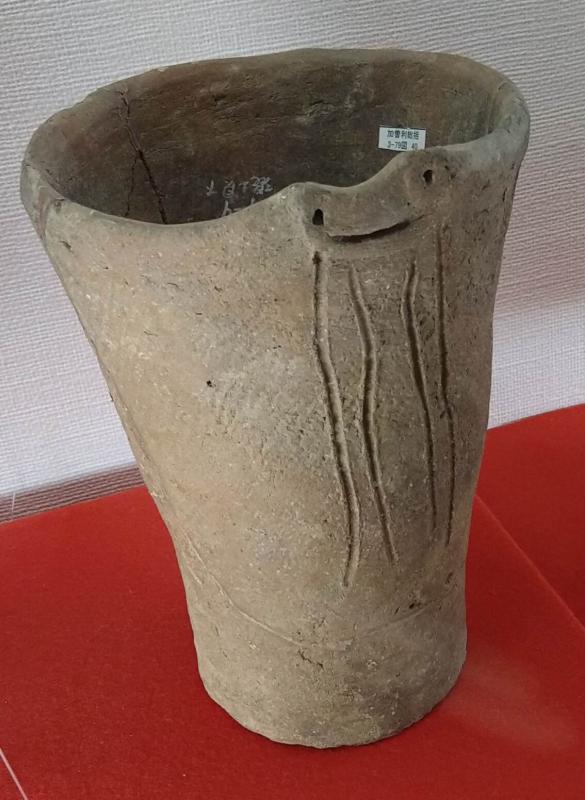
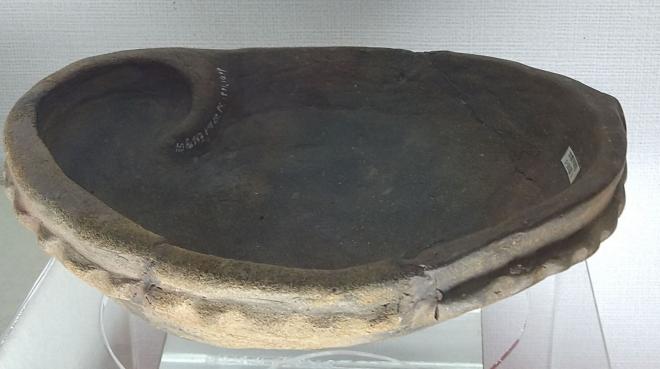
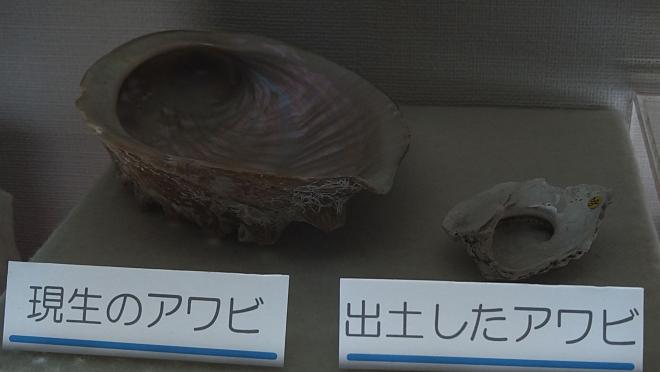
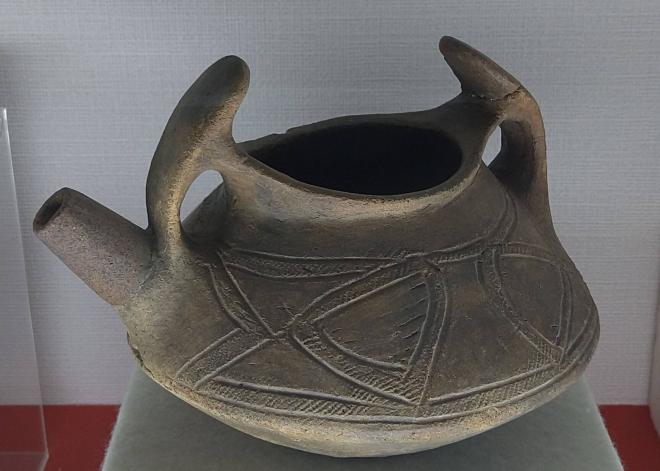
There are bowls and cups. Designing a dish to resemble an abalone shell shows that their aesthetic sense was just as sophisticated as ours today. The pouring vessel looks like it was something that was created by people from modern times. There were no chopsticks or forks yet.
お椀やコップがある。食べ物を乗せるお皿をアワビ型にデザインするなんて、現代人とセンスが変わらない。水を注ぐ注口土器なんて、現代人が作ったものではないのかと疑う。箸やフォークはまだ無い。
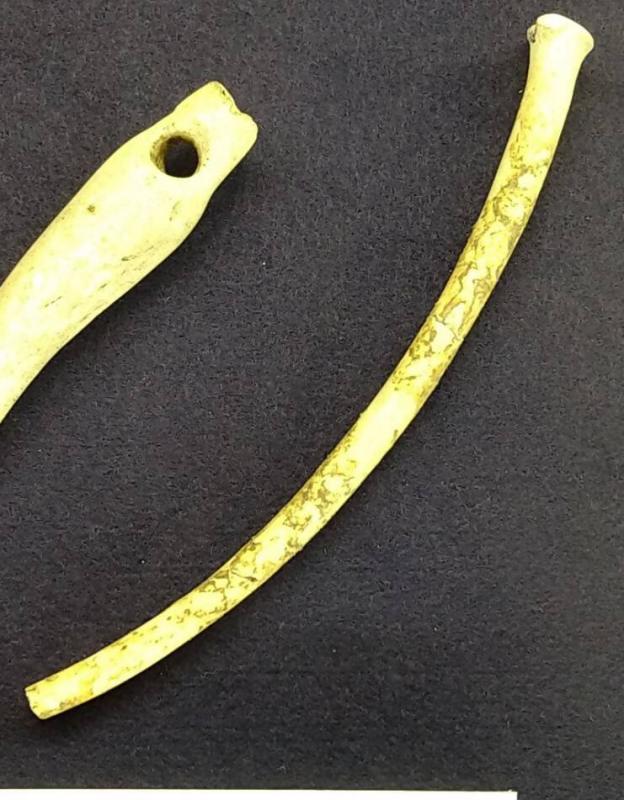
This is generally considered to be a hair accessory.…Aren’t these chopsticks? When they picked up some food from a large pot, or when they took and divided them into smaller dishes, did they do it by hand? It seems like it would have been so hot... Did they wait until it cooled down? If I were there, I would have used a wooden stick. I think it's natural to guess that if they also used wooden sticks, they then began to make chopsticks as a result. I recently watched someone on TV washing a steamy hot Chinese wok without any hesitation. They might have been fine with it, too?
これは一般的には髪飾りとされている。…箸ではないのか?あの大きい鍋から食べ物を取り出すとき、小さい器に取り分けるとき、手づかみでしたのか?とても熱いと思う…。冷めるまで待った?自分だったら木の枝を使ったと思う。もし彼らも木の枝を使っていたら、その結果、箸を作るようになったと推測することは自然だと思う。そういえば最近、熱い中華鍋を平気で洗う人をテレビで見た。…平気だったかも?
As someone who is not an expert, when I read books from the Jomon period I often have doubts about accepted theories like this, “Is this really true?” What I so often remember of those times are the stories of Iguanodon and the geocentric theory. Just as the nose of the Iguanodon actually turned out to be a claw, it turned out that it was not heavens, but actually the Earth that was moving. However, I always harbor doubts about such opinions.
縄文時代の書物を読んでいると、自分は素人なので、通説に対して「本当にそうなの?」と疑問を感じることがよくある。このときよく思い出すのは、イグアノドンや天動説の話。イグアノドンの鼻が実は爪であった様に、動いているのは天でなく地であった様に、自分は世間の意見にはいつも疑念を抱いている。
Besides that, I found something interesting recently from other regions. I thought there are also various things from the Jomon period besides Kasori Shell Mounds.
この他、他の地域に、気になるこんなものを最近見つけた。加曽利貝塚以外にも、縄文時代には様々なものがあるのだなあと思った。
There is pottery called ”Flame Pots” in Niigata prefecture.
新潟県には、「火焔型土器」と呼ばれる土器がある。
(https://www.kaen-heritage.com/english/(外部サイトへリンク)(別ウインドウで開く))
Lacquered pottery has been excavated in Ishikawa Prefecture, Aomori Prefecture, and various locations across Japan.
石川県や青森県など、日本各所で、漆塗り土器が出土されている。
(https://www.gov-online.go.jp/eng/publicity/book/hlj/html/202205/202205_04_en.html(外部サイトへリンク)(別ウインドウで開く))
There is an artefact called “Pottery with a Perforated Rim and Patterns of the Human Body”, also known as “Pii-su” (the meaning is peace or piece), in Minami-Alps City, Yamanashi prefecture.
山梨県南アルプス市には、「人体文様付有孔鍔付土器(じんたいもんようつきゆうこうつばつきどき)」(名前は「ピース」または「ぴーす」。平和のpeace、破片のpiece。)と呼ばれるものがある。
(http://www.museum-kai.net/museum_home/55/item,93(外部サイトへリンク)(別ウインドウで開く))
The more I research, the more I realize there are various things. Things that are thought to be written characters have not been found yet.
調べれば調べるほど様々なものがあることを知る。文字と思われるものが書かれたものはまだ見つかっていない。
2Fashion and Style
服飾・おしゃれ

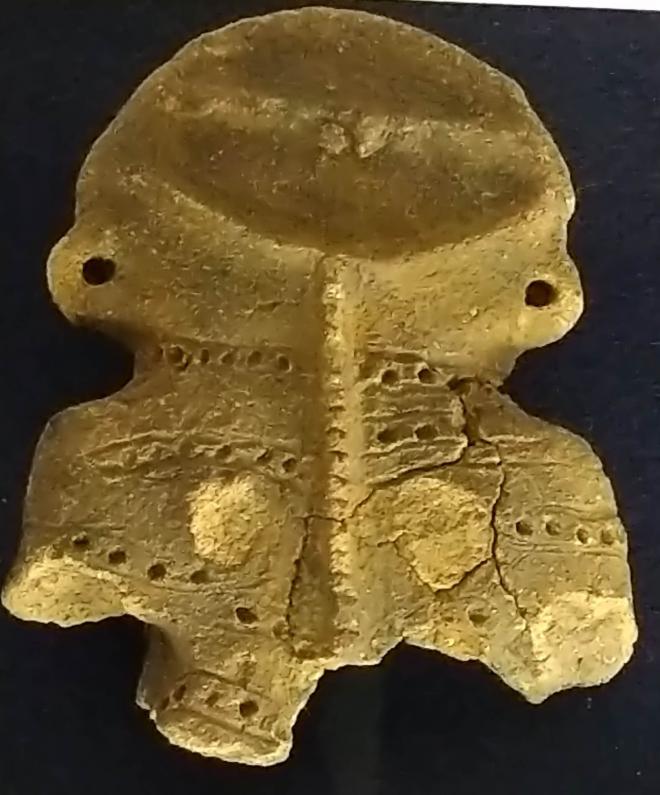
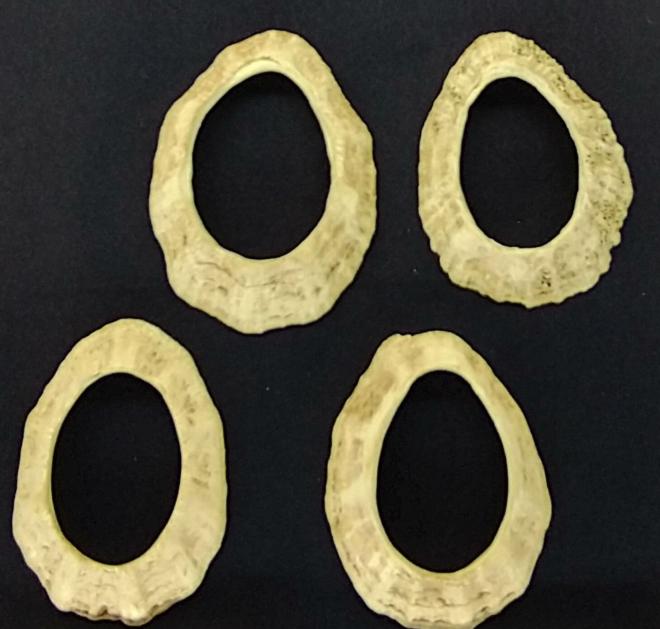
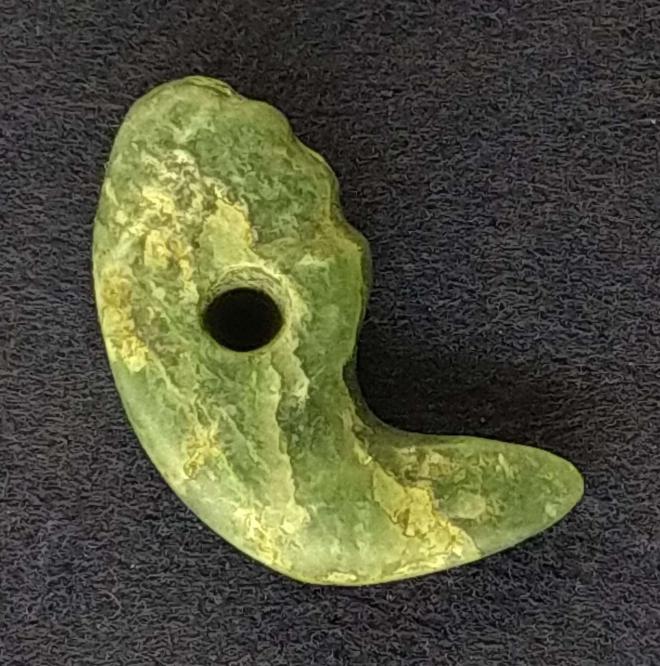
The Dogu has drawings of clothing on it, and there are holes in its ears. We can imagine the fashion of the time from these. Many earrings and shell rings used as armlets have been excavated. A necklace made of jade magatama beads, a comb coated with lacquer… I thought that daily life was controlled by food shortages, so it’s so surprising to see that they were also concerned with fashion.
土偶には衣服の絵が描かれており、耳には穴が開いている。これらから当時の服飾を想像することが出来る。イヤリングや腕に通す貝輪はたくさん出土している。ヒスイ製の勾玉のネックレス、漆塗りの櫛…。食べるものに困る日々であったと思っていたが、飾ることに意識が向くなんて驚き。
3Fishing Nets
漁労の網
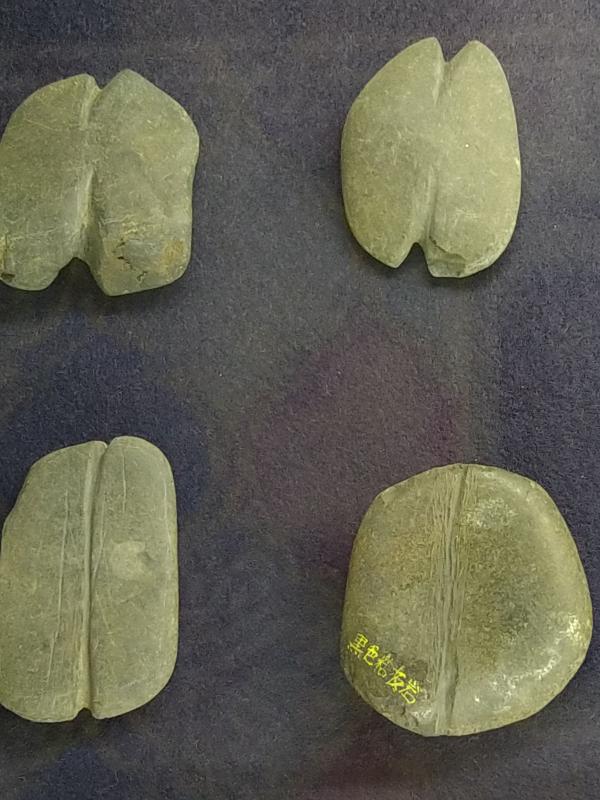
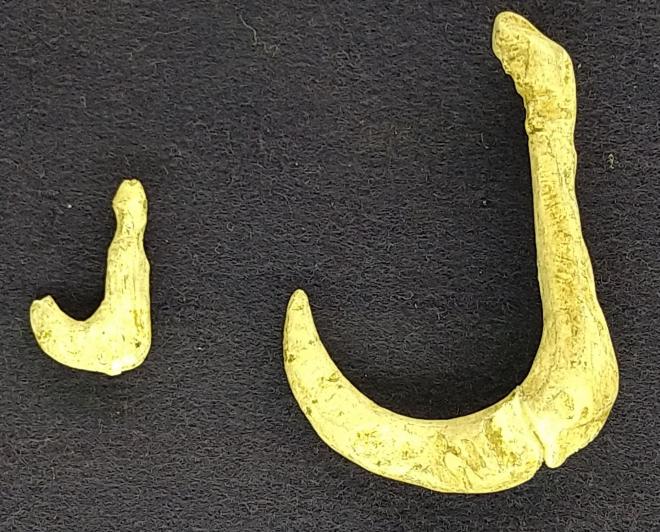
Many stones that were considered to have been weights for the fishing nets have been excavated. Not only were methods such as ‘spear fishing’ and ‘hook and line fishing’ used, but it is also known that ‘net fishing’ methods were employed. It might be one of the reasons that the climate became suitable for diving. Although the nets have disintegrated and left no trace, it is thought that the stones were used to attach and sink the nets, thus suggesting that nets were made. As for me, being a fishing enthusiast, I don’t think I would have even considered any other methods. Did someone feel that catching fish one by one was too frustrating and decided to invent a new method? Lots of fishing hooks have been found, so they must had also used the stones for the ‘hook and line fishing’ weight. However, strangely, I don’t see many people insisting on it. Are there no scholars who like fishing?
網の重りと思われる石がたくさん出土している。「突きさす」や「釣る」漁の方法だけでなく、「網で捕る」方法が行われていたことが分かっている。海に潜れる気候になったことも一因かもしれない。網そのものは溶けて残らないが、糸をつけて沈めていた石であると考え、網が作られていたと推測されている。釣り好きな自分は、他の方法なんて考えようとはしなかったと思う。一匹一匹ではじれったいと感じた人が「編み出した」のだろうか。釣り針がたくさん見つかっているので、釣りの重りとしても使っていたはず。しかし、不思議とこれを主張する人をあまり見ない。研究者に釣り好きがいないのか?
4Prayer
祈り
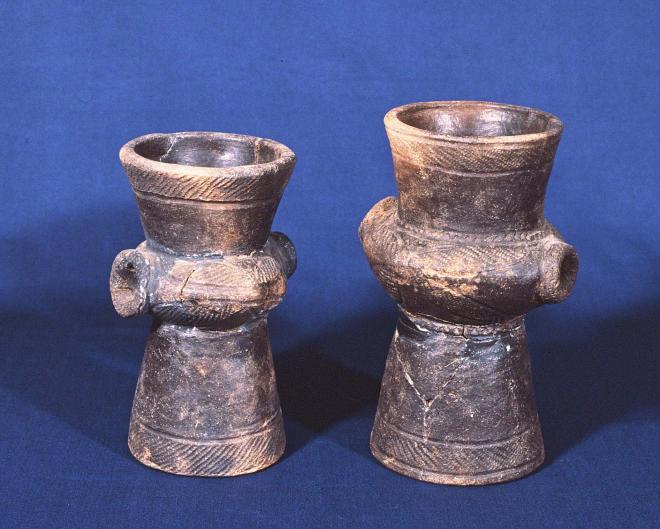
There are artefacts that can only be explained as instruments for prayer. Irregularly-Shaped Footed Vessel. It is evidence of the spiritual concept of prayer, as well as evidence of objects which were used to help people in prayer.
祈りの道具としか説明できないものがある。異形台付き土器。祈るという精神的観念が存在した証拠、祈りの際に道具を使うという証拠。
5The range of interaction through the movement of goods
物の移動からみる交流範囲
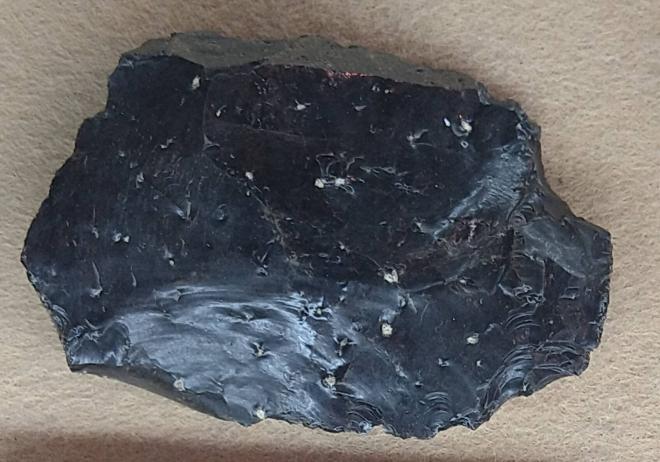
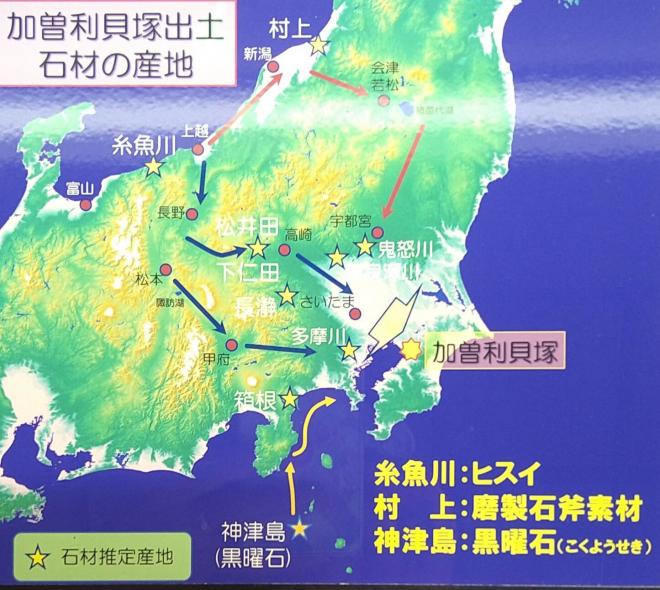
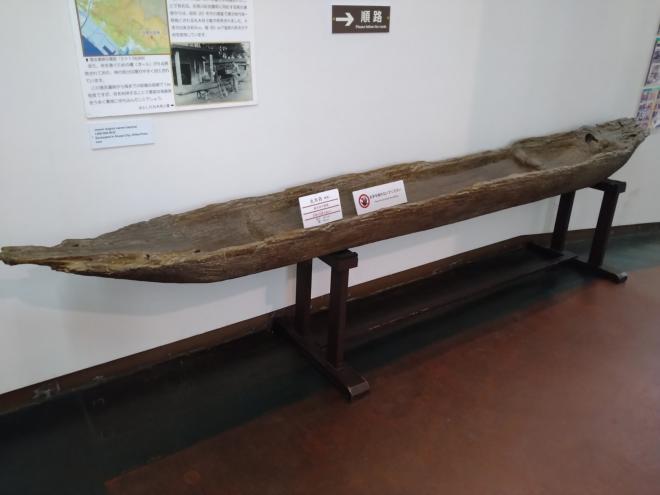
The stone known as obsidian, which is highly suitable for cutting fish and meal as well as a steel knife, was excavated. It is not an item that was extracted from the land near Kasori shell Mounds. It is an artefact that was produced only in certain places in Japan. Many of them which were excavated at Kasori Shell mounds are actually from Kouzu Shima Island. After walking 200 kilometers on foot, they had to cross 50 kilometers across the sea by boat. By that log boat? It is the evidence showing exchange with different regions. They might have also enjoyed traveling with their dog while seeing Mt. Fuji or interacting with people in other areas. Maybe they had trouble when trading such goods?
There is the opinion that as there were “few traces of war”, no conflict occurred during this period. However, I don’t agree with this. In the future, I hope that this current period would be introduced as a “period of war” in museums, as the people of the future living in peace may have discovered many traces of war from this time.
The history of dinosaurs spans from about 230 million years ago to about 66 million years ago. It lasted for approximately 164 million years. Since the birth of humans, only several million years have passed. The time is sure to come.
Obsidian has been used in other regions since around 38,000 years ago.
魚、肉を切るのに適した、鉄の包丁並みによく切れる黒曜石という石が出土している。加曽利貝塚付近の土地からは採取されないもの。日本の限られた土地で産出するもので、加曽利から出土するものは神津島産のものが多い。200km歩いたあと、海を船で50km渡らなければならない。あの丸太舟で!?各地と交流があったということを示す証拠。犬を連れて富士山を見ながら旅行して楽しむとか、他の土地の人との交流を楽しむこともしていたかも?もしかしたらこうした物品の取引を通じて争いもあったかも?
「争いの痕跡が発見されていないから戦争のない時代でした。」という意見もあるが、自分はそうは思わない。将来の博物館で、「争いの痕跡が発見されており、今と違い、戦争のある時代でした。」と現代が紹介されると良いなと思う。
恐竜の歴史は約2億3,000万年前から約6,600万年前までで、約1億6,400万年間。人類は誕生してからまだ数100万年。絶対その時代は来ると思う。
黒曜石は、他の地域では、38,000年前から使用の痕跡がある。
6What is a Dogu?
土偶とは何か
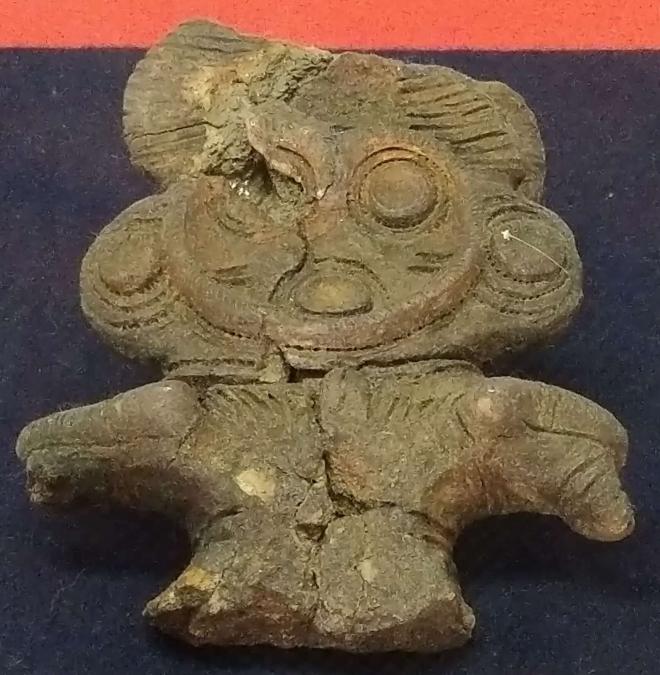
Dogu are generally considered to be the ritual artifacts which were used in prayer (wishing for a bountiful harvest, safe delivery, rebirth), but I think they were toys. However, I think, just a little bit, that they might have also held Dogu for some kind of wishes. Certain things can only be known by hearing from people who were there at the time. (If you say that, that would ruin everything….) There are some things that I feel were made as artworks.
土偶は一般的には祭祀(豊穣、安産、再生)の道具とされている。が、自分はおもちゃだと思う。ただ、「何か願いを込めて抱いていたこともあったかもしれない」とは、ちょっと思う。確実なことは当時の人に聞かないと分からない。(それを言っちゃぁおしまい…)芸術作品として作製したのかと感じるものもある。
In Aomori Prefecture, clay artefacts in the shape of wild boars were excavated and it is difficult to imagine them being anything other than toys.
青森県では、おもちゃ以外には考えられないイノシシの土製品も出土している。
(https://bunka.nii.ac.jp/heritages/detail/252782(外部サイトへリンク)(別ウインドウで開く))
There is also an animal-shaped clay artefact in the Kasori Shell Mounds Museum.
加曽利にも動物型土製品がある。(現在展示していません。)
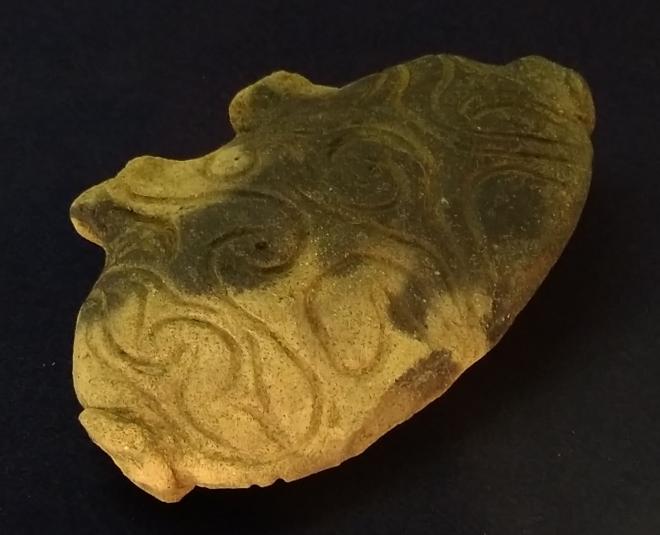
7Knitting and Sewing Techniques
編む、縫うという技術
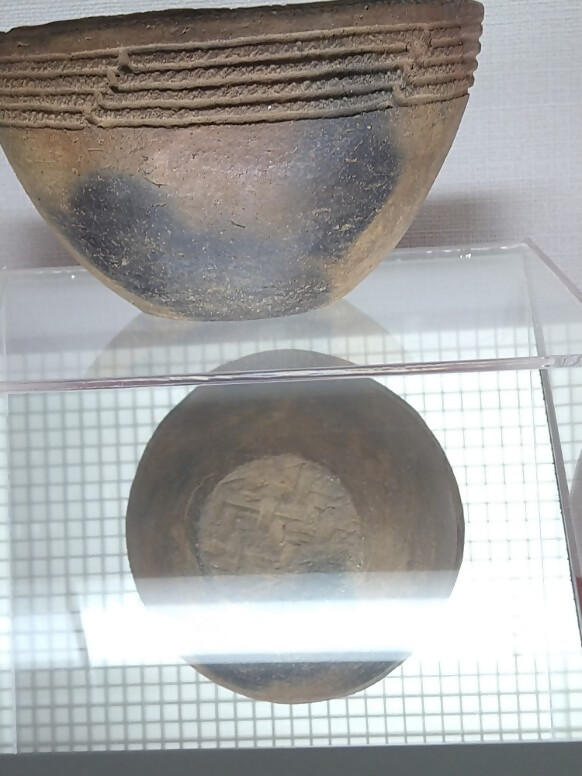
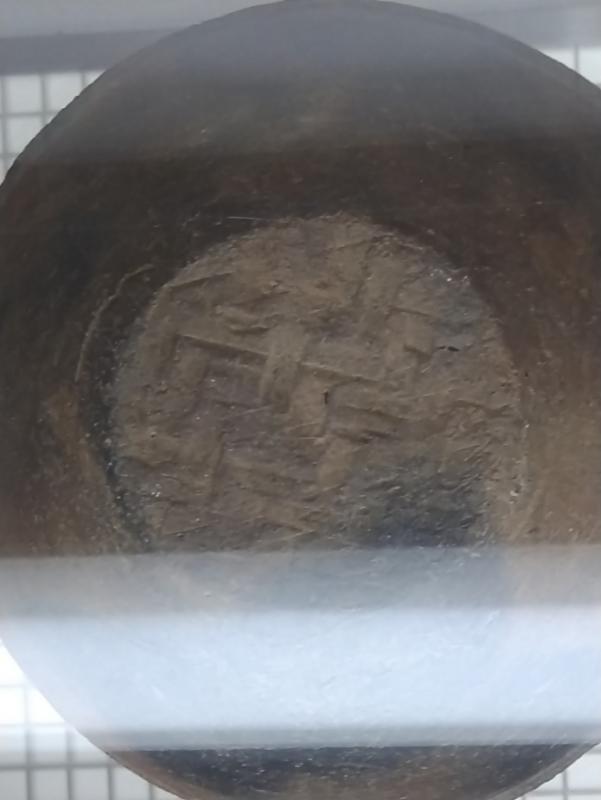
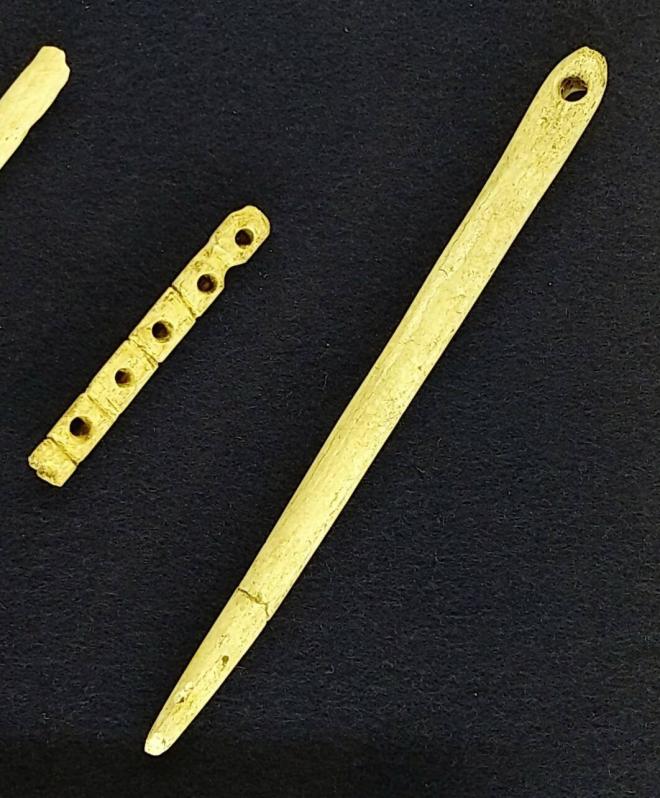
The patterns on the Dogu suggest that the clothing was ' knitted'. The shape of the stone with the center missing also suggests that they were 'making the nets by weaving' for catching fish. I think this was needle used for sewing clothes. Some people say it was used as an accessory. Imprints of a woven mat made from plant fibers have been found on the bottom of the oldest piece of pottery within Chiba City, which dates back about 11,000 years. Since the knitting materials disintegrate and disappear, its existence and form can only be imagined through the imprints that remain, however, there is something that has miraculously remained.
土偶の模様から衣服は「編んで作られたもの」であると考えられている。また、中心の欠けた石の形から、魚を採るための網を「編んで作っていた」ことも推測されている。これは自分は、服を縫うために使う針だと思う。飾りに使ったと言う人もいる。約11,000年前の千葉市最古の土器の底面からも、植物繊維を素材とした編み物の敷物の圧痕が発見されている。(この写真は別の土器です。)編み物はその素材が溶けてなくなるのでその存在も形態も痕から想像することしか出来なかったが、奇跡的に残ったものがある。
It is called a 'Jomon pouch' from the Sannai-Maruyama ruins in Aomori, which is from around 5,500 years ago. This helped us realize that this was real, not something from our imaginations.
青森県三内丸山遺跡の「縄文ポシェット」で、5,500年前のもの。これで想像ではなくなった。
(https://cb.bunka.go.jp/en/contents/15bd3b5e-1e3e-4ee8-9f33-b09c1f0306f2(外部サイトへリンク)(別ウインドウで開く))
I have a feeling that I recently saw something similar in a store.
最近、店頭で似たものを見た気がする。
8Dwellings
住居
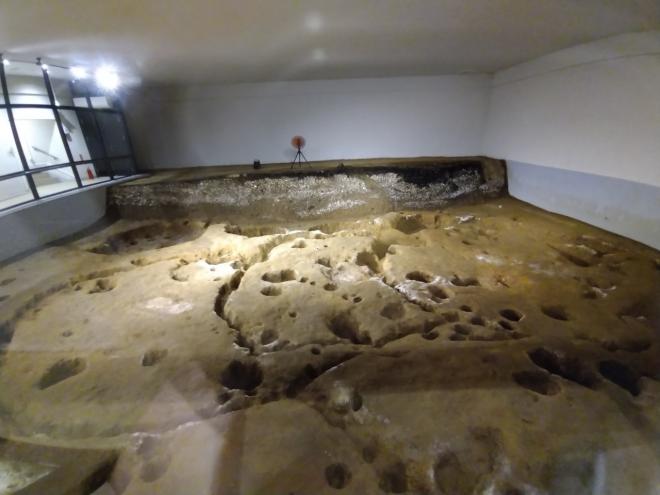
We still build houses by setting up the pillars first. Although there are remains of dwellings from the Paleolithic Period of the Ice Age (which was also a period of the migratory lifestyle), it can be imagined that during the Jomon Period, when a settled lifestyle became the predominant way of living, the shape, size, and construction methods of dwellings advanced significantly, much like the development of pottery. However, unfortunately, there are also few remains of the upper part, only the traces of the stakes and a circular hole about 5 to 6 meters in diameter and 50 centimeters deep are left. The upper part of the dwellings are purely speculative. The reconstructed dwellings at the Kasori Shell Mounds site are purely imaginative creations. Furthermore, the large dwelling remains at the Kasori Shell Mounds site would have required even more advanced building techniques.
現代も、柱を立ててから家を作る。氷河期の旧石器時代の移住生活の時代にも住居跡はあるが、定住生活が主な生活形態となった縄文時代には、土器つくりと同様に、その住居の形、大きさや作り方も、格段に進化していたのではないかと想像できる。しかし、残念ながら、これも上部はほとんど残っておらず、杭の跡と、直径5~6メートル、深さ50センチメートルほどの円形の穴の跡しか残っていない。上部は推測でしかない。加曽利貝塚にある復元住居はあくまでも想像で作られたものである。また、加曽利貝塚にある大型住居跡は、更に高い建築技術が必要な住居だったはずである。
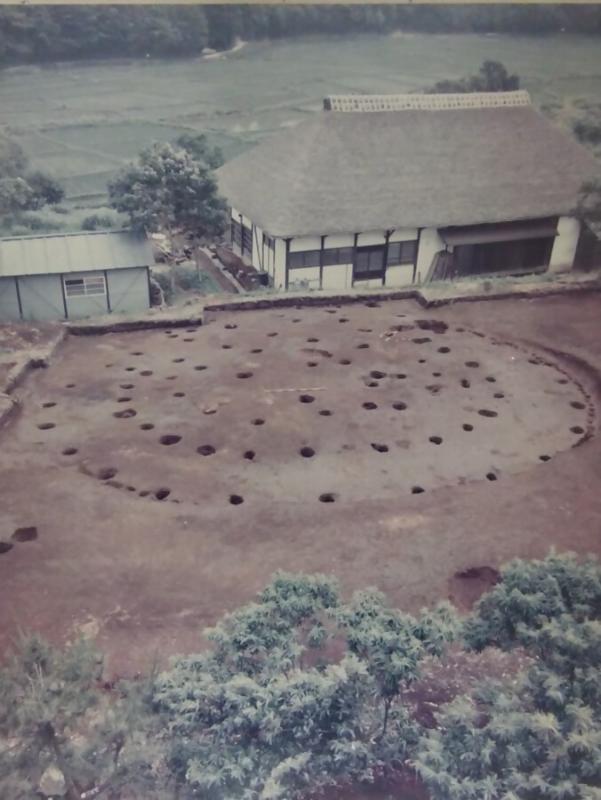
However, the 'house-shaped stone artefact from 4,600 years ago which was excavated from the Sakaehama 1 site in Yakumo Town, Hokkaido, is useful for reference.
但し、北海道の八雲町栄浜1遺跡から4,600年前の「家形石製品」が出土しており、参考になる。(https://www.town.yakumo.lg.jp/uploaded/attachment/8119.pdf(外部サイトへリンク)(別ウインドウで開く))7ページ参照(Refer to Pege7)
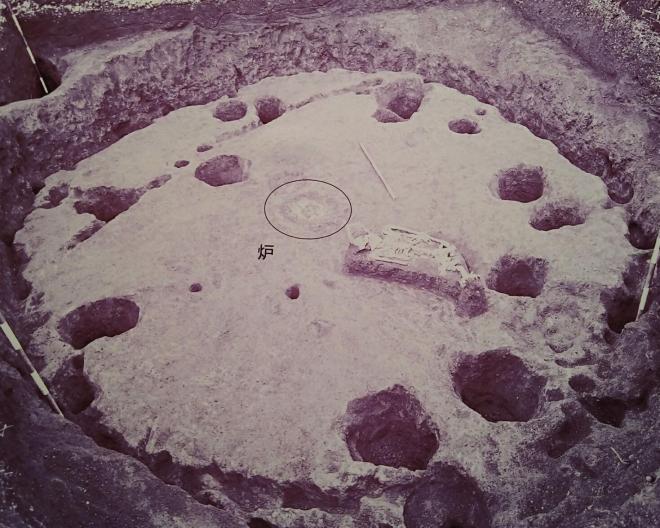
There are traces of a hearth on the ground, so it is certain that they cooked there using pottery. It can be imagined that everyone was dining together in a circle around the hearth.
Let’s share and enjoy the food together!
地面には炉の跡があるので、そこで土器を使って調理していたことは間違いない。炉を囲んで輪になってみんなで食事をしていたことも想像できる。
みんなで仲良く分けて食べよう。
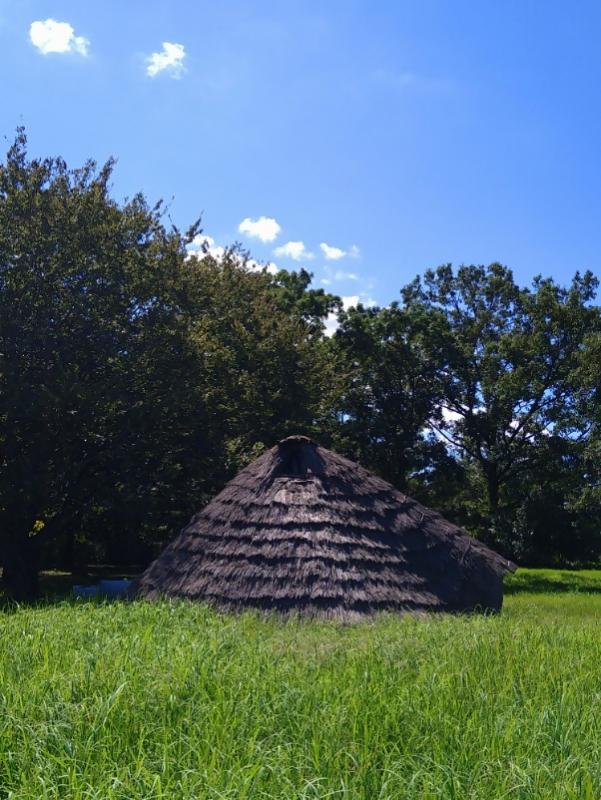
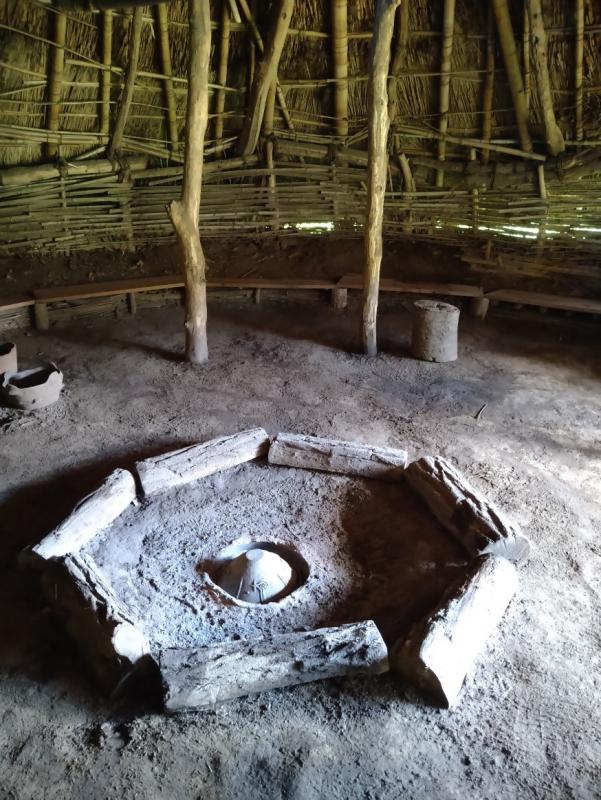
Even though the materials may have changed, many of the things that originated from that time are nearly all still used in their original form as described above. I began to understand the feelings of those who greatly admire the people from this period as 'remarkable founders'. There are many wonderful events in every period, however I did not know this period at all. Although some people say, 'Is this all the progress that was made after over 14,000 years? We modern humans have achieved this much in just 2,000 years.'. There was almost nothing before the Jomon Period began, but the people from this period invented things and progressed much faster up until the point when the climate became warmer for one moment, even though there was a much smaller population, difficulties communicating with the world and so few resources. I think it is wonderful and that they did a great job. It is tough to lift something from zero to one. It is comparable to the progress modern people have made from one to 100. People advance in the blink of an eye, so people tend to forget the people who began at first. I think they should be given more respect and admiration.
I wonder if I should put their portraits in frames and hang them up high on the wall in my room?
I have a little pocket money this month so I can’t buy the frame. I’ll skip it today.
このとき生まれたこれらのものは、材質は変わっているが、今も多くのものが上記のとおりほぼそのまま使われている。この時代の人たちを「素晴らしい創業者」の様に大いに称賛する人の気持ちがちょっと分かったような気がした。どの時代にも素晴らしい出来事がたくさんあるが、この時代は全く知らなかった。「1万4,000年以上かけてこの程度の進歩か。我々現代人は2,000年ほどでここまで進化したのに。」という人もいるが、人口がこんなに少ないのに、世界的な交流も今ほど無かったのに、資源がこんなに少ないのに、縄文時代が始まるまでほとんど何もなかったのに、気候が良くなった一瞬でここまで発明・前進して…、良く頑張ったと思う。素晴らしいと思う。何かをゼロから1にするのは大変なこと。現代人がした1から100の進歩に匹敵する。人はあっという間に進歩するから、初めて始めた人のことは忘れがち。もっと彼等は尊重尊敬されるべきだと思う。
今日から彼等の肖像画を額縁に入れて部屋の高いところに飾ろうかな?
あ、今月はおこずかいが少なくて額を買えないから、今日はやめておこう。
By the way, I recently found out that there are dwellings similar to the reconstructed dwelling at the Kasori Shell Mound in the hometowns of the CIR in Chiba City.
ところで、千葉市の国際交流員の出身地にも加曽利貝塚の復元住居に似た住居などがあることを最近知った。
https://www.city.chiba.jp/shimin/shimin/kokusai/documents/craggaunowen.html(別ウインドウで開く)
June 14,2024
Remains Which Were Preserved by Chance and Effort(and will remain into the future)
偶然と努力によって残された遺物(そして未来へ続く)
“Acidic soil accounts for most of the land area in Japan. In many cases, the remains of humans, animals and fish have decomposed and have for the most part disintegrated. The calcium found in shells, which is alkaline, neutralizes the acidic soil and these have not decomposed and still remain today. As a result, many traces of life from the past still remain in the shell mounds”.
「日本は酸性土壌が多く、人や動物、魚の骨などは溶けて残らないことが多いが、アルカリ性である貝殻のカルシウム分は酸性の土壌を中和し、これらは溶けずに残る。その結果、貝塚においては当時の生活の痕跡が多く残されることとなった。」
…oh, really? Isn't that a miracle?
I thought that it was really amazing when I found out.
This is exactly like a time capsule.
I wonder if the person who noticed the fact at first felt the same.
I'm sure that the person was thinking why everything was preserved so well here.
…ええ?本当?奇跡じゃない?
この事実を知ったとき、本当にすごいと思った。
まさしくタイムカプセルだと。
一番初めにこの事実に気づいた人も同じ気持ちだっただろうか?
なぜここはこんなにきれいに保存されているのだろうと思っていたはず。
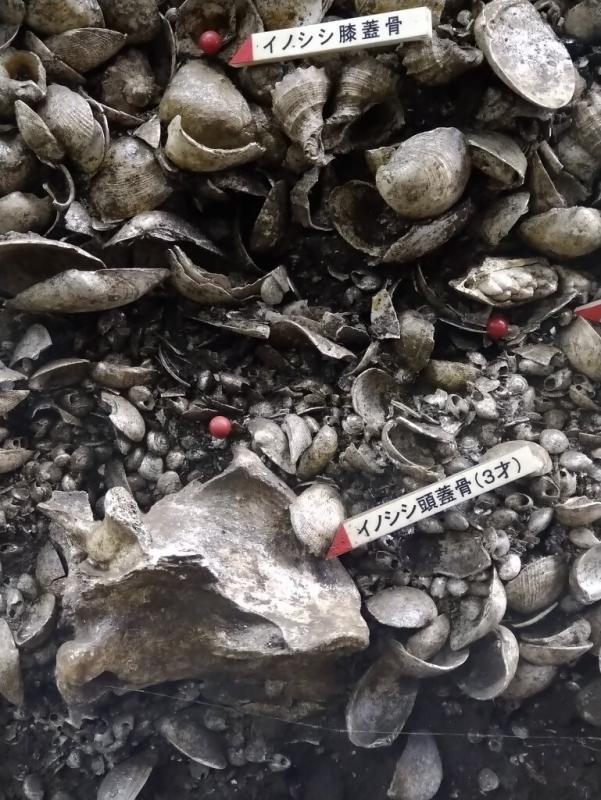
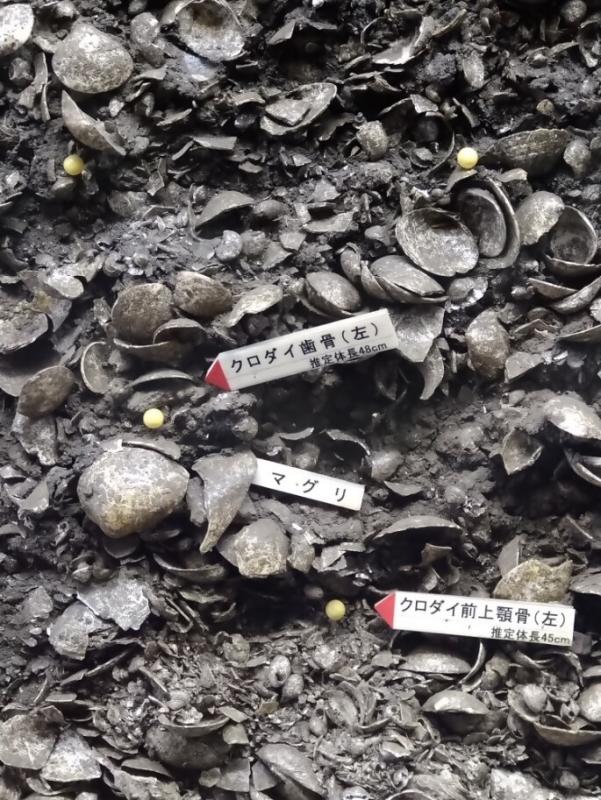
You can see some animal bones and fish bones.
動物と魚の骨があります。
Did people in the Jomon period know this?
I wonder if there were occasions when they used to bury something in the shells on purpose to leave behind.
…I also wonder if there had been people who didn’t want to disappear even after death.
“Bury me in a shell when I die.”
I wonder if there were people who buried dead people in the shells and wished that they were still alive.
Weren't there people who noticed this during the Jomon period, which lasted for over 10 thousand years?
Is it by chance that these remains have remained preserved until the present day?
It is considered that it is by chance. But it may not be by chance…
I think it is narrow-minded to think that these thoughts didn't occur to them like modern people, or that they never thought such things because they lived in ancient times.
However, conclusive evidence that this is true must be discovered by excavation if we want to insist on this fact.
そして、このことを縄文時代のひとは知っていただろうか?
後世に残すことを目的に、意図的に何かを貝の中に埋めることはあっただろうか?
…そして、死んでも消えたくないと望んだ人はいなかっただろうか。
死んだら貝の中に埋めてくれと。
死んだ人を貝の中に埋めて、まだ生きていると願った人はいなかっただろうか?
1万年も続く縄文時代の中で、このことに気づいた人はいなかったか?
こうして現代まで溶けずに残ったことは偶然なのだろうか?
偶然だとされている。しかし、偶然ではないかもしれない…
太古の人だから、考えが現代人に及ばない、そんなこと考えるはずがない、彼等が気づくはずが無いと考えるのはおごりだと思う。
しかし、これを主張するためには、そうであったとの確かな証拠が発掘により発見されなければならない。
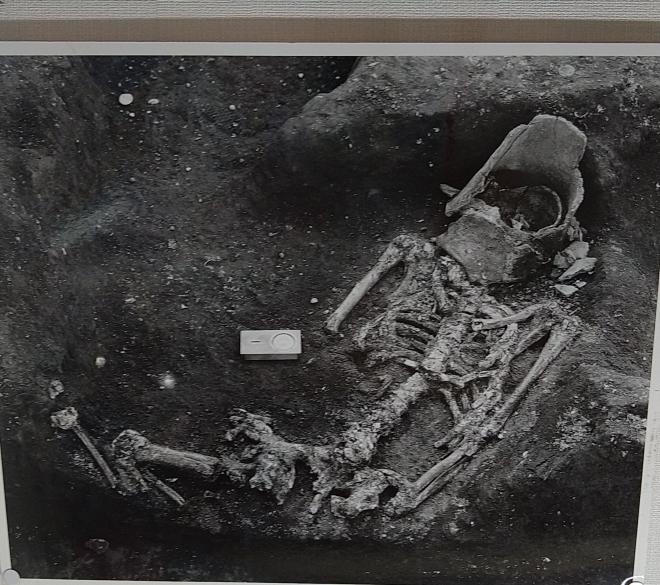
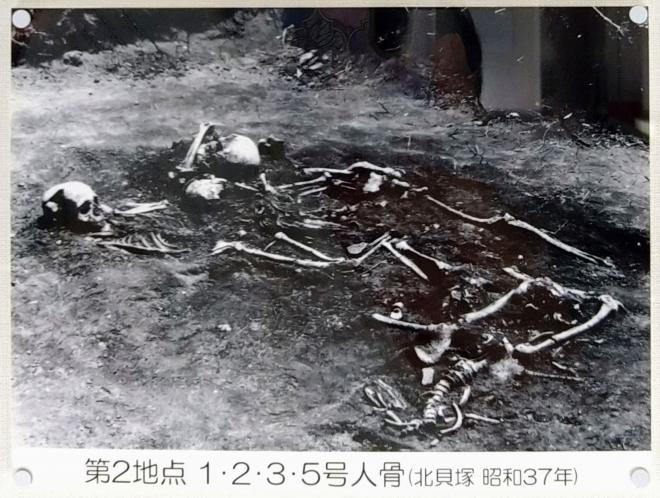
Human remains which were excavated beneath the shells.
貝の下から発掘された人骨
In the 1960's, there was a risk of the soil being dug up and that remains would be demolished by the construction to make factories and houses.
However, Munehisa Takeda, a social studies teacher, spearheaded preservation activities all over Japan along with students, citizens and the Japanese Archaeological Association. Chiba City ended up buying the property and it was preserved.
The remains and the park you can see here now is the result of a huge effort.
1960年代…ここは工場の敷地や宅地を作るための工事で、土地が掘り返され遺跡が破壊される危機にさらされていた。
しかし、武田宗久という高校の社会科教師を中心として、学生、市民、日本考古学協会などによる保存活動が全国にまで広がり、千葉市が土地を買い取り、保存されることとなった。
今、ここで見ている遺跡と公園はその大きな努力の結果である。
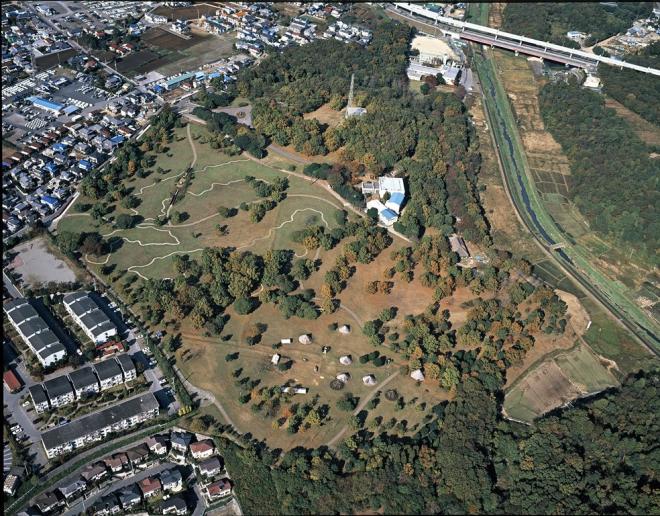
By the way, why did they need to raise so many voices to buy the site? Even though so many relics were already excavated?
Chiba City had no budget? The price was too expensive? It was not considered worth buying? Was there the person who felt these were just the pieces of stones and who could not understand their value? Was it the period during which development activities were the top priority?
Who were they battling with?
Anyway, it is a good thing that they were not defeated. As the saying goes, “the nail that sticks out gets hammered down”. It is really good that they won.
ところで…買い取るのになぜこんなにたくさんの声が必要だったのだろう?既にたくさんの遺物は出土していたのに。
千葉市には予算が無かった?価格がすごく高かった?買うほどの価値はないとされていた?土器をただの石のかけらとしか感じない価値の分からない人がいた?開発が第一の時代だった?
誰と闘っていたのだろう。
いずれにせよ、潰されなくてよかった。出る杭は打たれる。本当に勝って良かった。
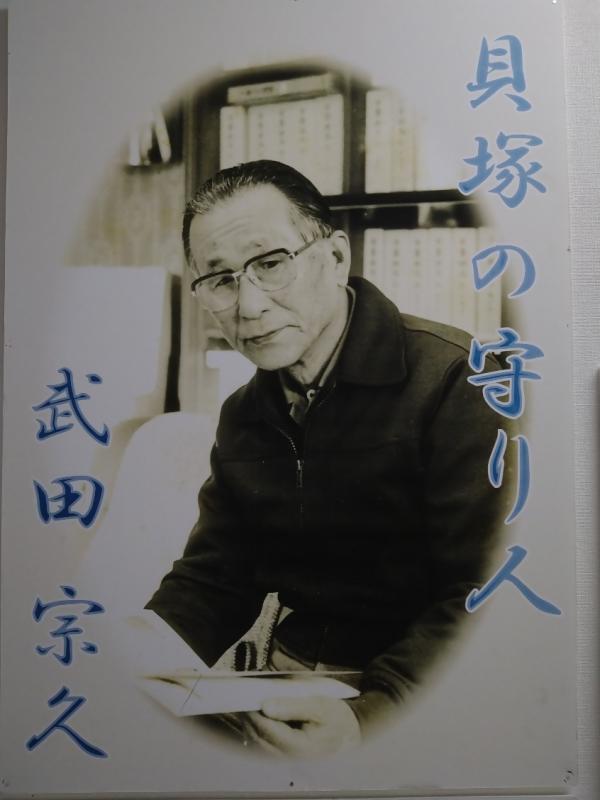
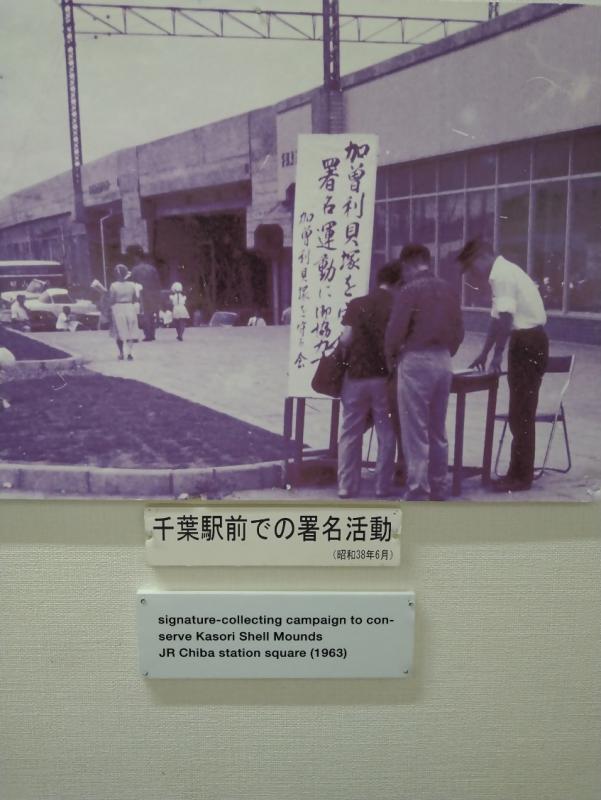
There are facilities here that you can see how people lived at that time.
It is not fake, but real.
This is it that was protected.
ここにはその当時の生活をそのまま見ることが出来る施設があります。
偽物ではなく本物です。
これこそが守られたものなのです。
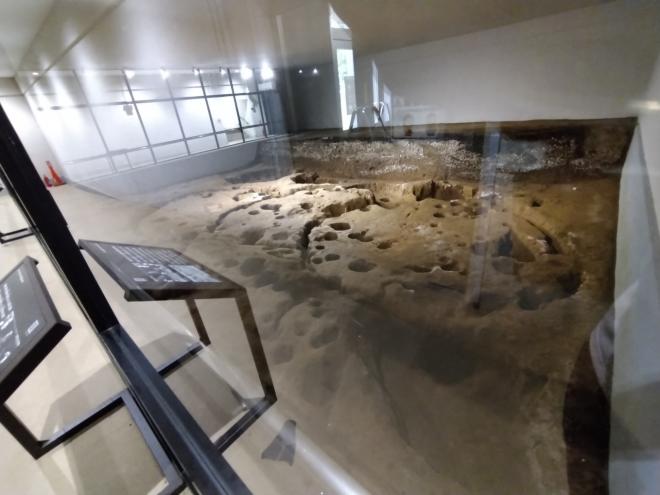
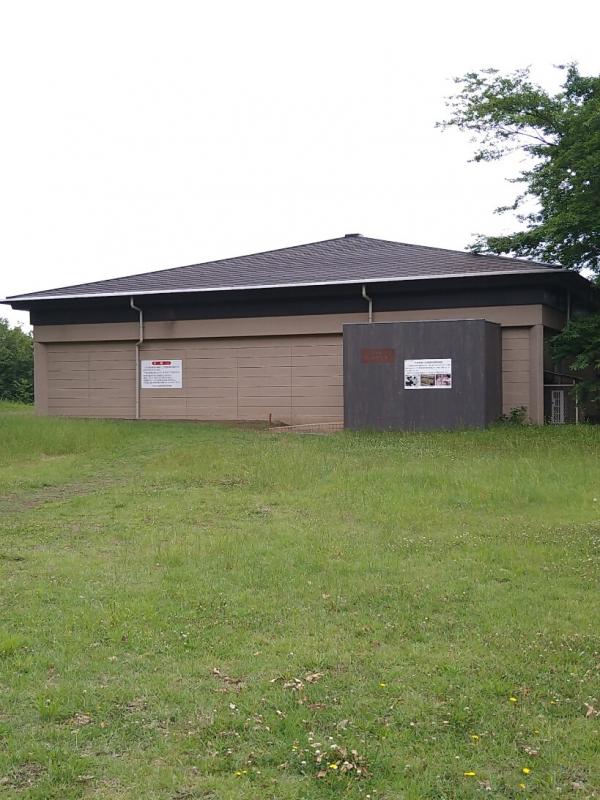
Actually, the areas that were excavated and researched are less than 10% of the total area. Most area has not been still excavated. I really look forward to the future.
This is the results of excavation up until now. Although it is only a small percentage of the total land area, we have so much results. I want to see more and more. I want to see everything as soon as possible!
実は、発掘調査された面積は全体の10%に満たない。まだほとんどの場所が発掘されずにいる。今後が本当に楽しみ。
これは今までの発掘の成果です。まだ全体の土地面積に対してわずかな割合とはいえ、成果はとてもたくさん得られています。でも、もっともっと見たい。全部、早く見たい。
平成30年度 発掘調査日誌(Earrings!!!!)(別ウインドウで開く)
I would be glad if the following items were excavated.
Earrings, clay figures known as “Yamagata-Dogu” or a dugout canoe.
I would be happy if earrings were found because I want to see how items were created using elaborate techniques.
I think that the clay figures are cute.
A dugout canoe has not been discovered here yet.
これが発掘されたらうれしいな…と思う遺物。
イヤリング、山形土偶、丸木船。
イヤリングは、精巧な技法で作られたものをもっと見たいから。
山形土偶はかわいいと思うから。
丸木舟は、まだここでは出土していないから。
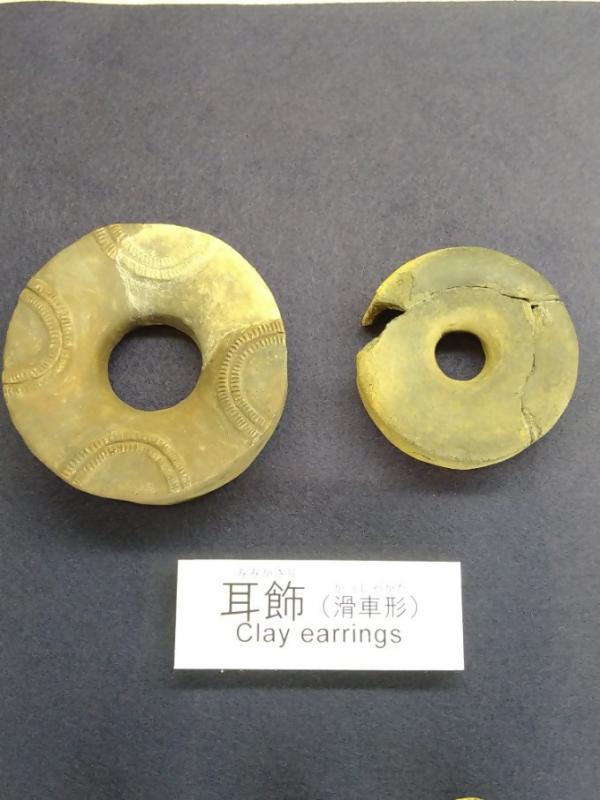

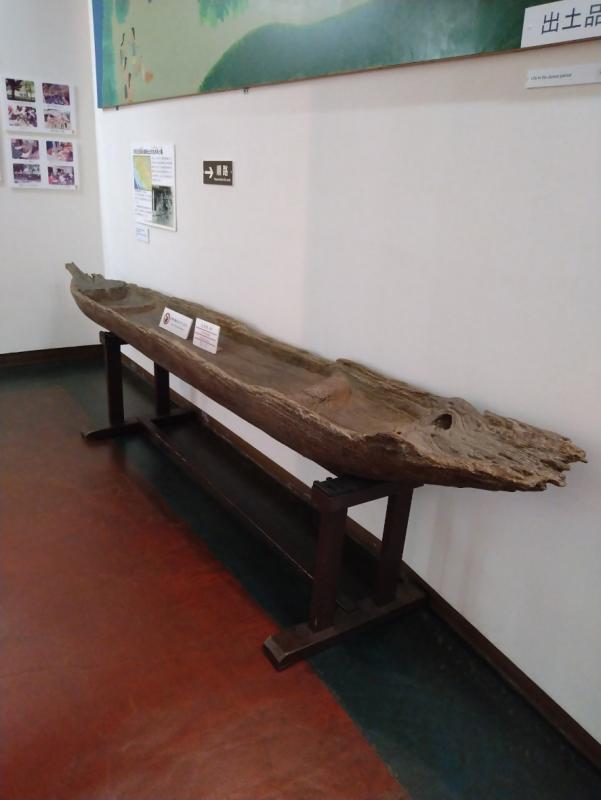
Please take a look at this information about a special exhibition that we are currently holding. We're looking forward to seeing you!
現在開催中の企画展はこちらをご覧ください。お待ちしています!
By the way, the act of digging and finding is so fun.
My 87-year old farther was a carnation farmer and he often took me out to the mountains behind our house to dig up fossils as a child. I will never forget the feeling of elation I had when we discovered the fossil of a shell in a rock.
The fossils which we dug up over forty years ago are still at my parent’s house.
ところで…
掘って見つけるという行為はそれ自体とっても楽しいもの。
カーネーション農家で今87歳の父は自分が子どもの頃、良く裏の山に化石を堀りに連れて行ってくれた。岩の中から貝の化石が出てきて一緒に大喜びした思い出は、一生忘れない。
実家には今も40年以上前に掘った化石がある。

April 17,2024 Welcome to Kasori Shell Mounds Park!
In the Kasori Shell Mounds Park, native vegetation from the Jomon period has been partially restored.
You can see and enjoy the scenery of what the ancient landscape used to look like.
加曽利貝塚縄文遺跡公園には、縄文時代の原生植物が部分的に復元されています。
古代の風景がどんな眺めだったのか見て楽しむことが出来ます。


You can also see many sweet acorns in winter.
I often put a lot of snacks on my desk and eat them from one end to the other. I wonder if the Jomon people also munched on their food like me?
The sweet acorns look so yummy.
冬にはシイの実もたくさん見ることが出来ます。
自分も良く机の上をお菓子でいっぱいにして端から食べますが…縄文時代のひとも自分みたいにボリボリ食べたんでしょうね?
シイの実、すごく美味しそう・・



I didn't know how big the park was until I came here.
Above all, the air in the park is sooo fresh!
The air is clean and the park is so big...it is a really good place to take a walk!
Don’t forget to bring your UV parasol!
ここに来るまで、こんなに広い公園だとは思いませんでした。
そして、何よりも…公園の空気はとーってもおいしい!
空気も澄んでいて公園もとても広くて…散歩に本当にとても良い場所です!
あと、日傘を忘れずに!


The season of fresh greenry has come! Flowers are starting to bloom!
You can also hear the small birds chirping a lot.
Feel free to come for a walk!
新緑の季節が来ました。花が咲き出します。
小鳥のさえずりも良く聞こえます。
気軽に歩きに来てください!



Lastly, we will hold a festival during Golden Week.
We hope you’ll look forward to it!
最後に…ゴールデンウィークにお祭りがあります。
お楽しみに!
アクセス(access to the Park)(別ウインドウで開く)
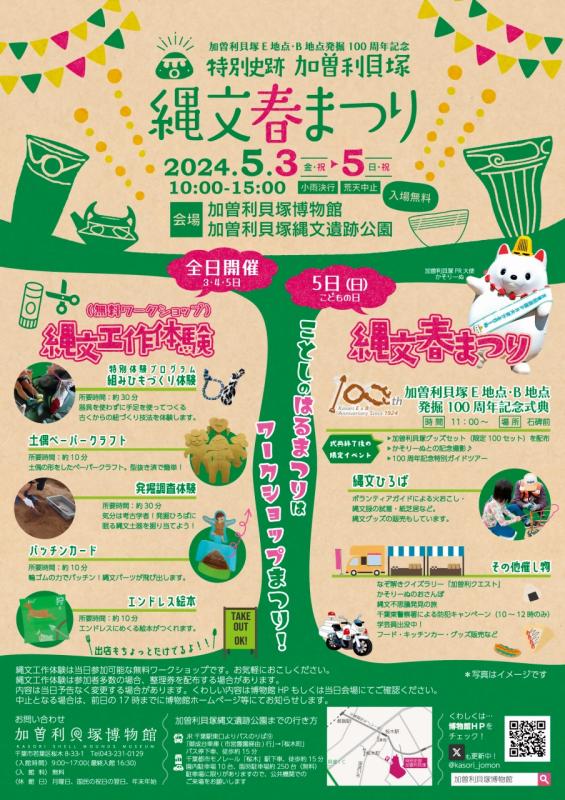
March 6,2024 Welcome to Kasori Shell Mounds Museum!
First of all,I would like to talk about the Kasori Shell Mounds Museum.
Have you ever heard of shell mounds?
I work at Kasori Shell Mounds Museum now.
It is embarrassing but I didn’t know about shell mounds until I was assigned here.
Of course, I knew the name, but I didn't know the value at all.
The lives of people who existed over a period of 2,000 years are recorded.Traces of life from between approximately 5,000 years ago until 3,000 years ago can be found here.
We call the age between approximately 17,000 years ago to 2,400 years ago the Jomon period.
It has been designated as a special historic site, which holds the same rank as a national treasure.
We have only four special historic sites from the Jomon period (including here) in Japan.
Here is the one of the special places in Japan.
Today, I would like to explain the story regarding dogs from the many traces left of their lives.
The artefacts found in the area are called shell mounds because many shellfish that were eaten were found, as well as the bones of dogs.
The excavated situation showed that dogs were buried so tenderly.
At that time, it is considered that they had dogs for the purpose of catching prey, such as wild boar or deer.
However,some of the bones of the dog’s legs had traces of being healed.
It seems to be wounds from hunting.
However, they helped heal the dog without letting it leave alone.
Dogs were not just hunting tools.
They were loved as same as we love now.
Doesn't the scene seem lovely in your mind?
Various memories still live on here.
There are the same number of stories.
Although Kasori Shell Mounds is a bit off the beaten track, there is something to stir up your imagination.
Do you like fishing?
Do you like to watch or make pottery?
Camping in the forest or making clothes?
Perhaps wearing cute earrings, cooking shellfish and wild game meat or praying when you're in trouble?
You need to come here if you would like to know how people lived 5000 years ago.
You cannot leave Chiba City without visiting here!
A new Museum will open in a few years.
We are preparing to provide more fulfilling exhibition.
Please come here again at that time.
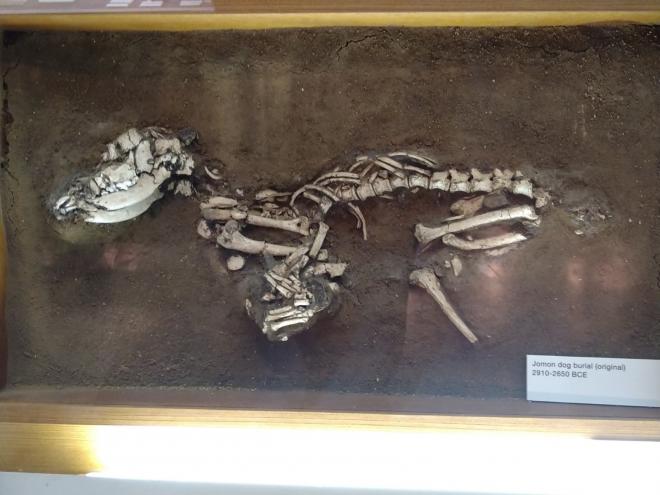
By the way, the mascot of the Kasori Shell Mounds Museum is called Kasoriinu.
The dog of Kasori.
In Japanese,Kasori no Inu.
Kasori no inu,kasori inu,kasori inu…kasoriinu.
A festival is held here in May and October or Novenber every year.
You can meet Kasoriinu at this time.
In my opinion, it's so cute!
You can pet and hug Kasoriinu!!
Feel free to come and visit here!
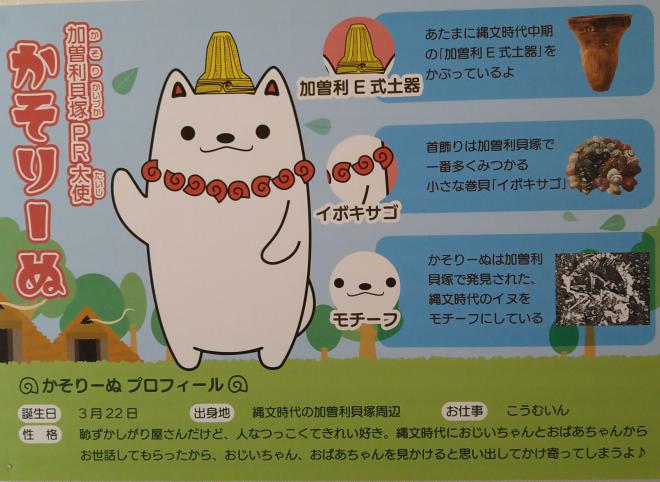
はじめに、加曽利貝塚博物館についてお話したいと思います。
貝塚は聞いたことがありますか?
私はいま、加曽利貝塚博物館に勤めています。
しかし恥ずかしながら、ここに配属されるまで貝塚のことを知りませんでした。
もちろんその名前は知っていましたが、その価値は全く知りませんでした。
ここには、2,000年間の人々の暮らしが記録されています。
約5,000~3,000年前の生活の跡を見ることが出来ます。
約17000年前から2400年前の間を縄文時代と呼んでいます。
特別史跡に指定されており、国宝と同じレベルです。
縄文時代の特別史跡は日本にはここを含めて4箇所しかありません。
ここは日本の中でも特別な地のひとつなのです。
その沢山の生活の跡から、今日は、犬に関する話をしたいと思います。
ここは食べられていた貝がたくさん見つかっているから貝塚と呼ばれていますが、貝だけでなく犬の骨も発見されています。
その発掘された状態からとても丁寧に埋葬されたことが推測されています。
この当時、犬はイノシシやシカの獲物を捕るために飼われていたとされています。
しかし、その骨には、骨折を治した痕跡のあるものもありました。
狩猟で負った骨折かもしれません。
しかし放置しないで治してあげた。
ただの狩猟道具ではなかったのです。
今と同じように愛されていたのです。
その情景が浮かびませんか?
ここには様々な記憶が眠っています。
その数だけの物語があります。
加曽利貝塚は人里離れた場所ですが、想像力をかきたてる何かがあります。
あなたは釣りが好きですか?
陶芸を見たり作ったり…
森の中でキャンプしたり、服を作ったりするのは好きですか?
かわいいイアリングを身に着けたり、貝やジビエ肉で料理をしたり、困ったときにお祈りしたり…とか?
ここに来てください。5000年前、彼らが何をしていたか知りたかったら。
ここ訪れずに千葉市を離れることは出来ません。
数年後、新しい博物館が建設されます。
もっと充実した内容を提供出来るよう準備しています。
ぜひそのときまた来てください。
ところで、ここにはかそりーぬという加曽利貝塚のマスコットがいます。
the dog of Kasori、日本語では加曽利の犬。かそりのいぬ、かそりいぬ…かそりーぬ。
例年、ここでまつりが5月、10月または11月に開催されています。
かそりーぬにはこのときに会えます。
かわいいですよ!
このかそりーぬはなでたり抱きついたり出来ます!
ぜひ遊びにきてください。
このページの情報発信元
教育委員会事務局生涯学習部文化財課加曽利貝塚博物館
千葉市若葉区桜木8丁目33番1号
電話:043-231-0129
ファックス:043-231-4986
より良いウェブサイトにするためにみなさまのご意見をお聞かせください
